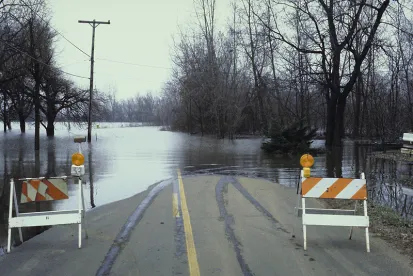The extraordinary images and reports of the devastation from Hurricane Harvey have filled the news outlets. While the focus remains on the human toll and concern for the well-being of friends, colleagues and business partners who may be personally affected by this disaster, its impact will extend far beyond those whose lives and businesses were immediately disrupted. In the coming days, we will begin to see assessments of the disaster's impact on businesses from Texas, the Gulf Coast and beyond.
Impacted businesses should look to their insurance policies for funds to help rebuild and cover losses, including business interruption resulting from damage to owned property as well as property of suppliers and customers. Some covered losses may have begun even before landfall of the storm itself, including costs associated with shutdowns in advance of the impending wind, rain and flooding. Notice to insurers and careful review of policies are important first steps in preserving rights to coverage.
Next Steps
As soon as a potentially covered loss begins, experienced coverage professionals should be consulted. Waiting too long to start assessing coverage and quantifying loss can lead to lost coverage as, for example, covered costs may not be recorded and evidence of loss may not be kept. Insureds and others with potentially covered business losses should:
-
immediately obtain and review insurance policies;
-
confirm that evidence of loss is organized and maintained to support a claim under any applicable coverage provisions and track the expenses you incur in preparing the claim (including accountants' and lawyers' fees) as many policies often cover such expenses;
-
adhere to any applicable notice and proof of loss provisions in the policies, including obtaining waivers or tolling agreements from insurers;
-
document loss by making sure to maintain proof of business performance prior to, during, and after loss;
-
create and maintain evidence of damage, including pictures if necessary.
While there are many issues arising from claims made in connection with storm losses, including causation, trigger, notice, number of occurrences, limits, defenses and exclusions, there are some key coverage policy provisions to review and consider when analyzing claims.
Property Damage
If your property is damaged as a result of a natural disaster, it is critical to begin an immediate review of your property policy to assess coverage in light of the facts of your loss. Policyholders should be aware that most first-party property policies cover much more than just physical damage to owned property. Many policies define property damage to include loss of use of your property that has not been physically damaged. The property covered often includes inventory as well as property you lease, property within your care, custody or control, and property for which you are liable or in which you have an insurable interest. Many policies also include additional coverage for debris removal, demolition and increased cost of construction in the event of physical loss to covered property. Costs associated with expediting repairs are often also included. While such provisions vary significantly, "preservation of property" and "sue and labor” clauses often cover costs incurred to prevent or minimize actual or threatened loss.
Business Interruption
Lost profits are commonly covered under one or more provisions of most property policies. Business interruption insurance is designed to do for the insured what the business itself would have done had no interruption occurred. This type of coverage usually comes into play to reimburse an insured for losses sustained due to the total or partial suspension of the policyholder's operations during a period of interruption. For instance, a retail or manufacturing operation that suffers storm or flood damage to its property could pursue, under its business interruption coverage, the profit it lost while repairing the damaged property.
While policy wordings and case law interpreting these provisions varies, business interruption provisions generally require:
(a) loss or damage to insured property;
(b) interruption of the business due to a covered loss;
(c) loss of income or profits; and
(d) that the losses occur within a "period of restoration" which may be subject to a waiting period.
Business interruption losses often present tricky valuation and calculation issues that are best analyzed soon after the loss or even as the loss progresses, rather than long after-the-fact when it may be difficult to obtain important supporting data. Your business interruption coverage may require you to expedite repairs, mitigate losses and/or track expenses in a way that is not consistent with your normal business practice. Many policies also provide coverage for “extra expense” associated with maintaining production while property is being repaired or for certain expenses incurred before physical damage to property. Covered extra expenses generally include such costs as rent, moving and hauling expenses, overtime, temporary labor, and even advertising. An early evaluation of your coverage can help smooth the path to making sure covered expenses are properly captured and presented to insurers. Fortunately, many policies include coverage for outside professional fees incurred in quantifying the loss.
Contingent Business Interruption/Dependent Business Premises
If your suppliers or your customers suffer loss or damage as a result of the disaster, you may have a claim for contingent business interruption due to your inability to acquire or deliver materials or services. These provisions generally extend the business interruption coverage to include loss of gross earnings at the insured’s premises as a result of a supplier’s or customer’s inability to deliver or receive goods or supplies due to damage to its property. For instance, a manufacturer that cannot acquire raw materials because of damage to suppliers in Texas may be able to pursue contingent business interruption coverage for its resulting lost profits. Determining whether your policy has been triggered, the requirement to purchase replacement supplies (“cover”), the appropriate period of restoration and the anticipated revenue or income had the damage not occurred can all be complicated issues necessitating the help of experienced coverage counsel and accounting professionals.
Service Interruption/Impounded Water
When utility services to your premises are interrupted, service interruption coverage may be available to cover damage to property (e.g., spoliation of refrigerated goods) and your loss of income or extra expense. Service interruption coverage generally requires damage to the property of a utility supplier used by the insured and sometimes includes requirements that the damage occur within a specified distance of your property. Impounded water coverage applies in the event that water used as a raw material, for power, or in a manufacturing process becomes unavailable due to damage to dams or reservoirs. Service interruption coverage could apply to power outages where power lines downed by a storm or physical disruption to a transformer or generating station prevent a manufacturing plant, hotel, restaurant or other business from operating normally. These coverages are often limited in duration and subject to waiting periods or deductibles. The coverage for such interruptions can nonetheless be substantial, including event cancellation, inability to deliver products, closure of facilities, contractual penalties for non-completion of orders or loss of covered property.
Civil Authority Restricting Access
Should a governmental entity issue an order restricting access to your property, including evacuation orders, the order may trigger your insurance coverage. Some cases have held that no physical damage is required to invoke the civil authority coverage, and the “order” of civil authorities likely needs not to be in writing. The governmental response to Hurricane Harvey may provide a classic basis for application of this coverage because there have been evacuation orders which may inhibit the ability to access your property. Airport and mass transit closures, beach and waterway closures, curfews, and evacuation directives are each types of civil authority orders that could lead to insurance claims.
Ingress/Egress
In addition to orders of civil authority, physical damage as a result of natural disaster may limit your ability, or the ability of customers or employees, to enter or exit your property. Even if the government does not issue an evacuation order, storm or flood damage may limit access to your business or property and result in business loss. Ingress/egress clauses can extend the business interruption coverage provided in your policy at least where property damage “in the vicinity” that restricts access to or egress from your premises.







 />i
/>i
